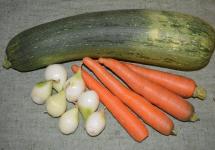Evergreen coniferous shrub lends to the landscape beautiful view at all times of the year. Bred in Denmark thuja western Danica(Thuja occidentalis Danica) - dwarf spherical shrub of the cypress family, pleased landscape designers unpretentiousness to light conditions of growth and undemanding to soil moisture.
Variety Description
In the name of the Danica variety of a coniferous shrub of the species western arborvitae reflected country of selection. The variety is characterized by small bushes - up to 80 cm in height and width. The life span of Danica is about 200 years, the tree grows very slowly, adding up to 5 cm in height and up to 4 cm in width in a year. The variety belongs to the most miniature.
Thuja branches with small needles are directed upwards. Pine needles are soft to the touch. The plant rarely blooms, a small half-centimeter brown bump appears in place of the faded inflorescence. 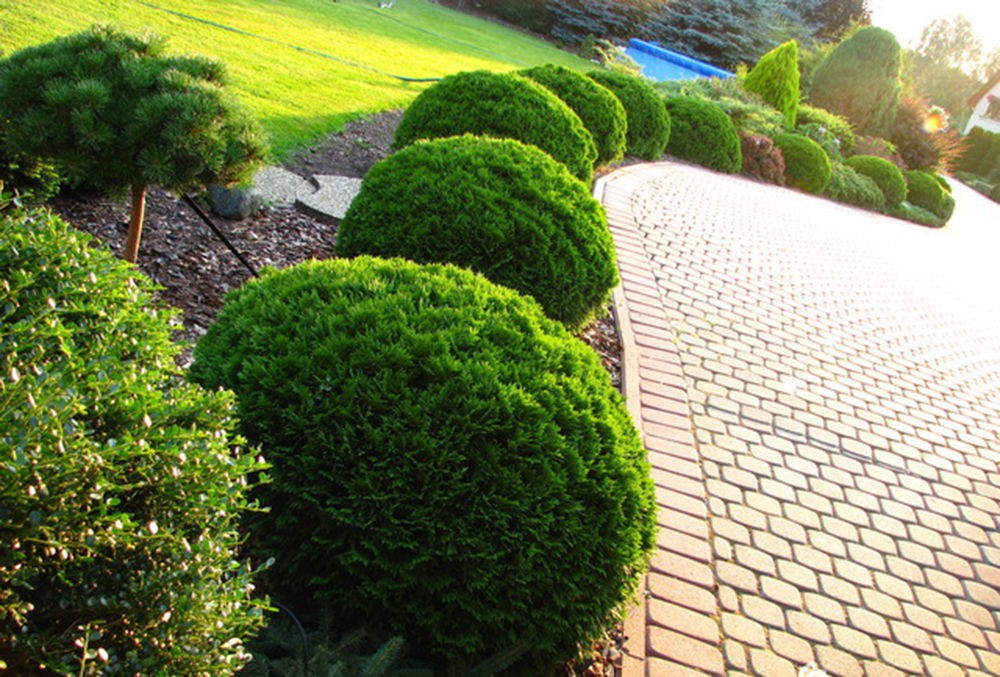
Landing and care
Danica is planted in sunny places and in partial shade. Thuja, which receives a sufficient amount of light, has a more lush and elegant crown. The shrub is not picky about the composition of the soil; nutritional value and soil moisture are important for it. Like all western arborvitae, Danica likes to be watered, but can tolerate temporary dryness of the soil. It is desirable that the pH of the soil be from 5 to 7.
You can grow Danica by cuttings, from seeds, but the plant grows slowly, and growing with these methods requires long-term care. The optimal solution is the cultivation of western thuja Danica seedlings. 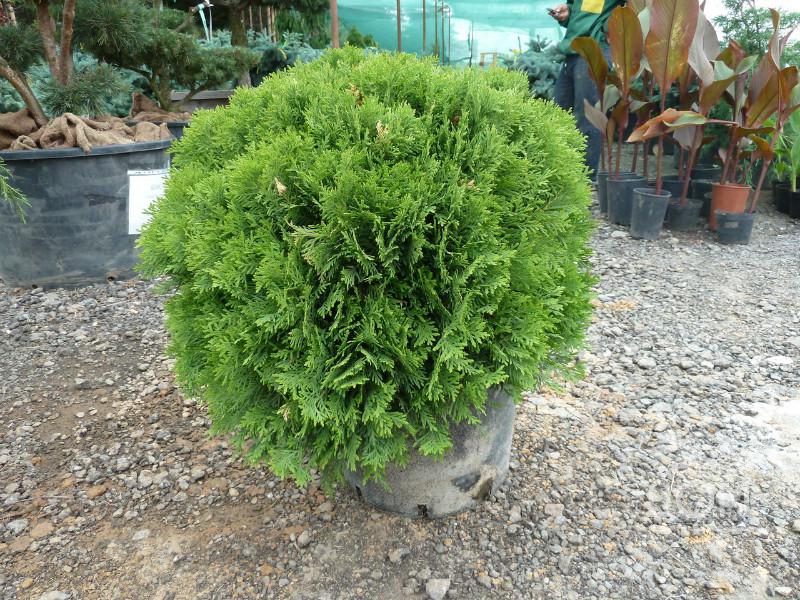
How much do seedlings cost
Seedlings are sold in nurseries, they are acclimatized to growing conditions, healthy and well-groomed thanks to proper care.
The range of prices for seedlings is large - from 850 to 1850 rubles. When forming the price, the variety of the plant, the height of the bush are taken into account.
Healthy. The cost of seedlings is affected by territorial prices and the age of the plant.
We prepare the land and plant seedlings
A pit for planting a seedling is prepared in a size slightly larger than a pot with an acquired thuja. So that the roots of the plant do not rot from excess moisture, drainage is laid at the bottom of the prepared place - expanded clay, gravel, broken brick. From above, the drainage is sprinkled with a layer of sand, peat, turf. The plant, taken out of the seedling pot, together with an earthen clod, is placed in a pit so that the root neck is at the level of the ground surface. In order to avoid rotting of the root system, a clod of earth with roots is not buried, and the roots are not exposed to obtain sufficient nutrition for the plant.
The crushed roots need to be straightened, the recess with the planted plant should be covered with soil, and watered. To retain moisture in the ground and prevent the appearance of a crust, the ground under the thuja is mulched with peat, wood shavings, and dry foliage.
Healthy. It is necessary to engage in planting plants (planting, transplanting) in the morning or evening, when there is no heat and ruthless ultraviolet rays.
The plant can withstand the dryness of the soil for some time, but you should not force it to survive. In order for the shrub to be beautiful, it must be watered in a timely manner, occasionally fed with mineral nitrogen-containing fertilizers and calcium.
If an aphid, a tick attacks a shrub, fungal diseases appear, gardeners resort to the help of insecticides and fungicides.
Shelter for the winter
Thuja Danica tolerates frost well. In areas with snowy winters, seedlings are not insulated. If the winters are not snowy and frosty, so that the shrub does not suffer from the cold, it is covered with spruce branches, covered with burlap.
In landscape design
AT landscape design Danica is used in the design of lawns near administrative buildings, and in the park area. Thuja is planted in groups and single plants in the country and in the garden near the cottage.
Danica tolerates a haircut well, and thuja crowns are shaped into animals, geometric shapes. It is rare to update the haircut on a slowly growing plant. Dwarf trees are decorated by planting plants close to each other. Varietal plants develop normally in the shade, the needles only darken from the lack of sun.
Healthy. A plant grown in a sunny place differs from a plant growing in the shade in a brighter color and density of branches.
Grow a plant in pots for decoration, loggias, balconies.
A miniature tree is suitable for compositions with stone and is used.
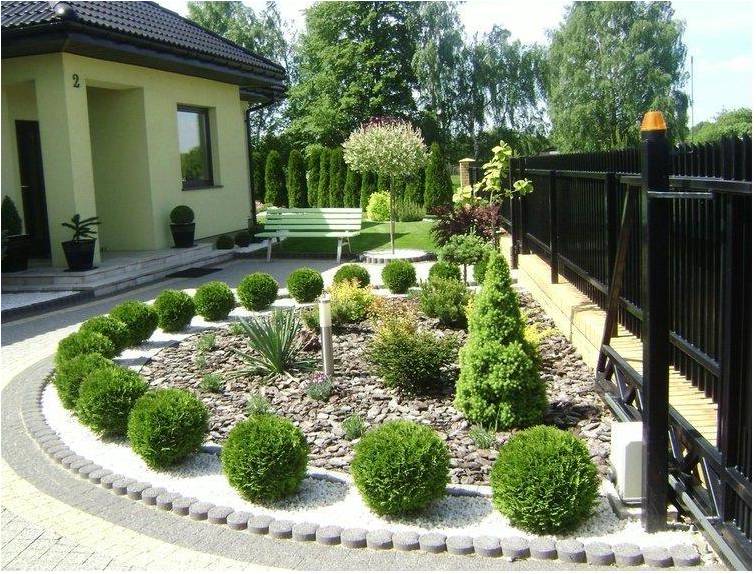
Flowerbed with spherical thuja
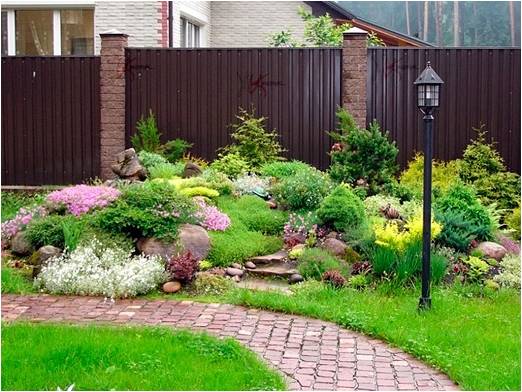
On the alpine hill
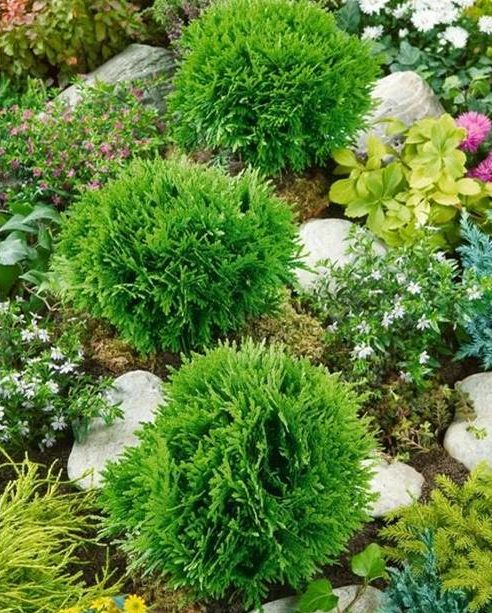
Composition with stone
Small trees are used in interior design like a bonsai tree.
The spherical western thuja has become widespread in Russia. She keeps the shape of the crown without a haircut, has a beautiful bright in green. Planted along the perimeter of the flower bed, it gives the adjoining plot an aristocratic look.
In a bright composition, the greenery of the thuja sets off the rich color of other flowers.
![]()
Thanks to the greenery globular thuja it is easy to create bright accents, and only this shrub is enough to give an irregular-style mixborder a well-groomed look. 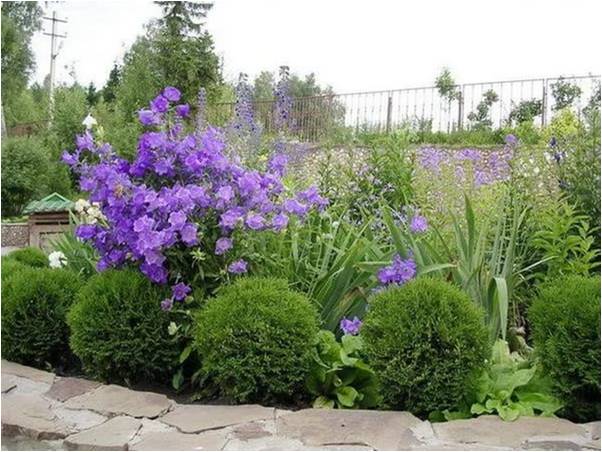
Variety Danica Aurea (Danica Aurea) distinguished by a golden-green crown. A spherical tree in 10 years of life grows only 40 cm in height. Over time, its height will be 1 m. A miniature aurea tree can be grown at home as a bonsai tree. 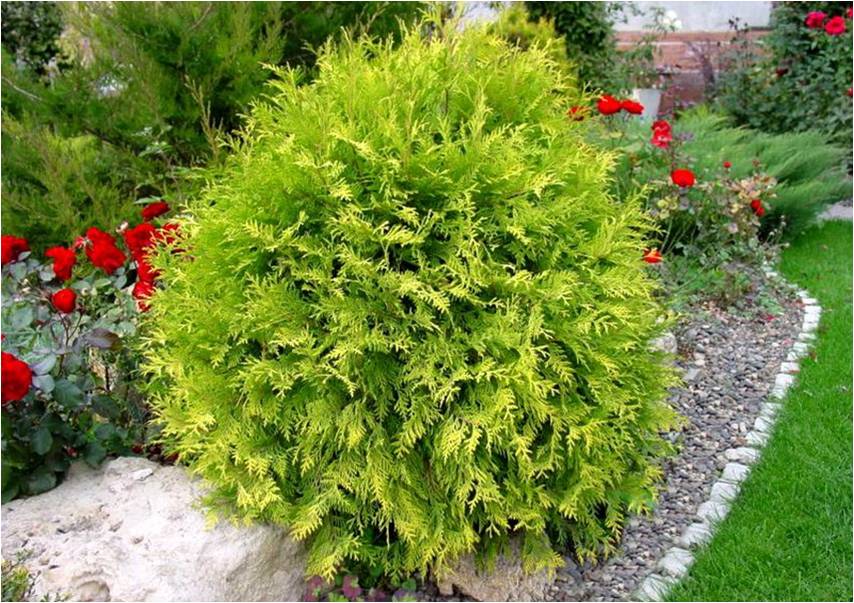
Danica Aurea turns yellow in the sun and becomes greener in the shade, intensely colored from mid-summer, the colorful outfit is preserved until the onset of cold weather. The golden crown of the thuja harmoniously combines with the green of the grass and the scarlet color of roses.
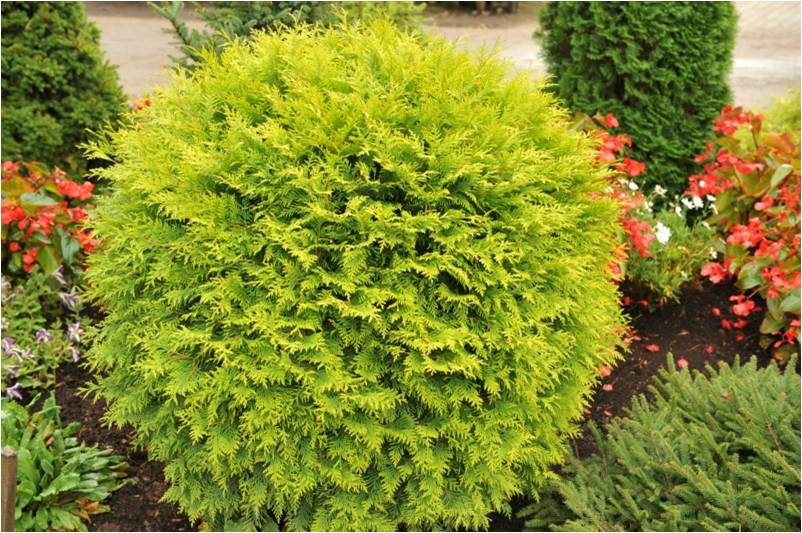
Danica Aurea's ball looks impressive in a composition with tall green trees and bright flowers.
Tui look good in compositions with green plants and bright inflorescences. Danica's companions will be:
- coniferous plants, including different varieties of thuja;
- ovoid and conical trees;
- vesicle;
- swordtail elecampane;
- purple echinacea;
- plants with contrasting colors.
They will reduce the decorativeness of landscape design with thujas, braiding a low tree and covering the crown. In a garden composition, a small plant will be lost among closely planted tall shrubs and flowers with a tall voluminous bush. Neighborhood with flowers on a tall thin stem and with low, flush with thuja stems, landscape designers welcome.
First of all, it is worth saying that Danica's thuja is common throughout Europe. This plant was introduced in the middle of the 20th century. Despite the fact that thuja grows extremely slowly, often the owners only have a positive attitude towards this culture.
If we talk about the dimensions of the plant, then often the thuja Danica develops up to 60 cm in height. Approximately the same value corresponds to the diameter of the thuja. We can conclude that the plant is really miniature, and perhaps this is what attracts gardeners.
Also, if we talk about the features of this ornamental plant, it is worth noting that the thuja has a decorative appearance throughout the year. It is green both in winter and in summer, which has a positive effect on the overall landscape of the site or territory. Often, the planting of thuja Danica occurs in large quantities. If you create a really successful decorative composition, you should use at least a dozen thujas. There can be a huge number of combinations and arrangements of these plants, and the most important thing is to correctly take advantage of the appearance and compactness of Danica's thuja.
In this article, we will take a closer look at the main features of Danica's thuja, and also take into account the details associated with planting and caring for the plant. We will not bypass the consideration of options for planting thuja, which worries the owners of summer cottages and garden areas very much.
Features of Tui Danica
To begin with, it is worth repeating the information that Danica is a truly successful thuja variety in terms of decor. It's no secret that now on the site you can use whole line other plants, but it is Danica who is able to create an environment that is inaccessible to most other cultures.
Continuing to talk about the advantages of this thuja variety, I would like to note that Danika easily tolerates even the most severe frosts, which are often found in the CIS. In fairness, it should be said that other tui have this advantage.
Thuja shoots are short and have a high density. The color of the shoots is light green. The needles are a scaly structure, characterized by high density, softness and brilliance. For the winter period, the needles change slightly - a brownish tint appears.
Separately, I would like to note other important features of Danica's thuja:
- Despite the easy tolerance of low temperatures, it still makes sense to cover the shrub with some kind of protective material for the first wintering. With the help of spruce branches, thuja should be covered in spring and winter from the so-called "sunburns". This problem can be really serious, since under the most ordinary conditions, the thuja can suffer from the bright rays of the sun.
- It is advisable to land directly in places that are at least slightly protected from the wind.
- As for the soil on which Danica thuja can grow, then, in general, this plant is not picky about the soil, but it is desirable that it be slightly moist. Then the growth will be more active, and the shrub itself will be rich green.
- In the event that the planting of the thuja occurs in an open sunny area, then in some cases this may adversely affect the condition of the plant. In a moderate shade, the thuja will feel almost perfect.
I would also like to note that it is best to plant Danica thuja near trees or other vegetation. In such conditions, our plant will be in moderate shade. In addition, a peculiar plant composition will be created, which will become a truly worthy decoration of the site.
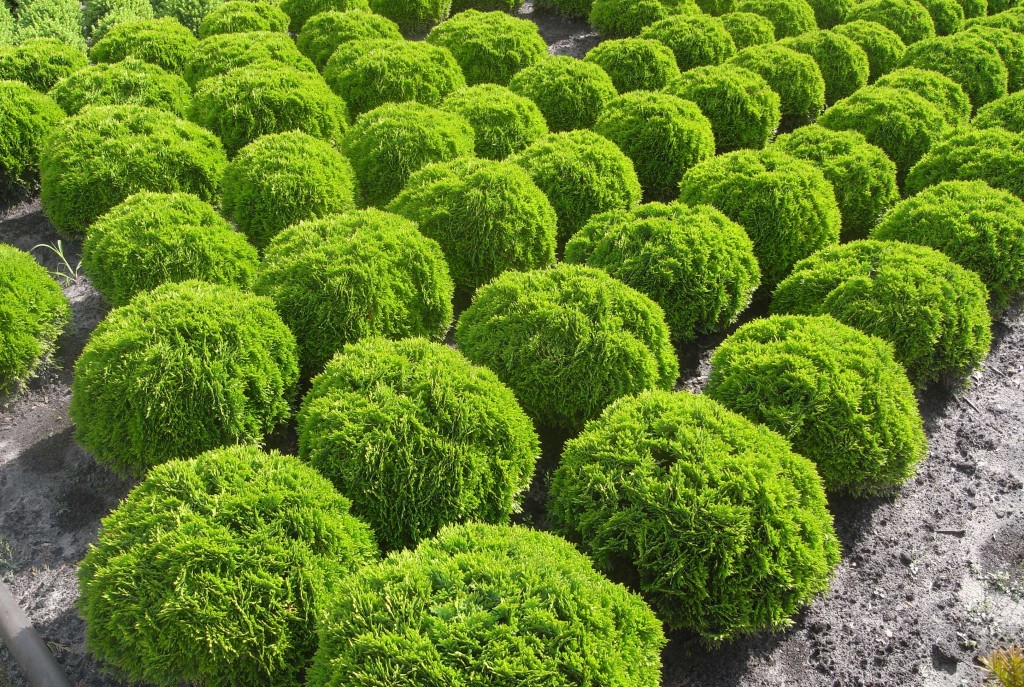
The specifics of landing Tui Danica
- To begin with, it is worth noting that the choice of a landing site should be based on the fact that the thuja should have access to the sun. As we have said, the plant feels most comfortable in conditions where there is a little sun and a little shade. If the choice is made in favor of a place where there is almost always a shadow, then the thuja will develop quite slowly, and this is bad for an ornamental plant.
- It is best to opt for peaty, dry soils. You can also look at clay sandy loams. In the event that the soil on which the thuja will be planted is “heavy”, it will be necessary to create an additional drainage layer, the thickness of which will be approximately 15 cm.
- As for the planting pit, its depth is often up to 80 cm. The soil mixture should be prepared in advance. It should consist of sand, soddy soil and peat (ratio approximately 1:2:1). If we talk about the acidity of the soil, then for most thuja it should be about 4.5-6 pH.
- Thuja is lowered into a pre-prepared recess, after which the soil mixture is added.
- Immediately after planting, thuja should be regularly watered. It is important to note that this process is carried out approximately once a week. This is a guarantee that the plant will actively develop at the very beginning, and it is the beginning of growth that is the most important stage in the life of the thuja. Often planting thuja occurs in the summer, when the air temperature is too high. This suggests that watering should be carried out more often than under normal conditions.
- Top dressing of thuja is often carried out in the spring. Complex fertilizers are used, suitable for many other crops.
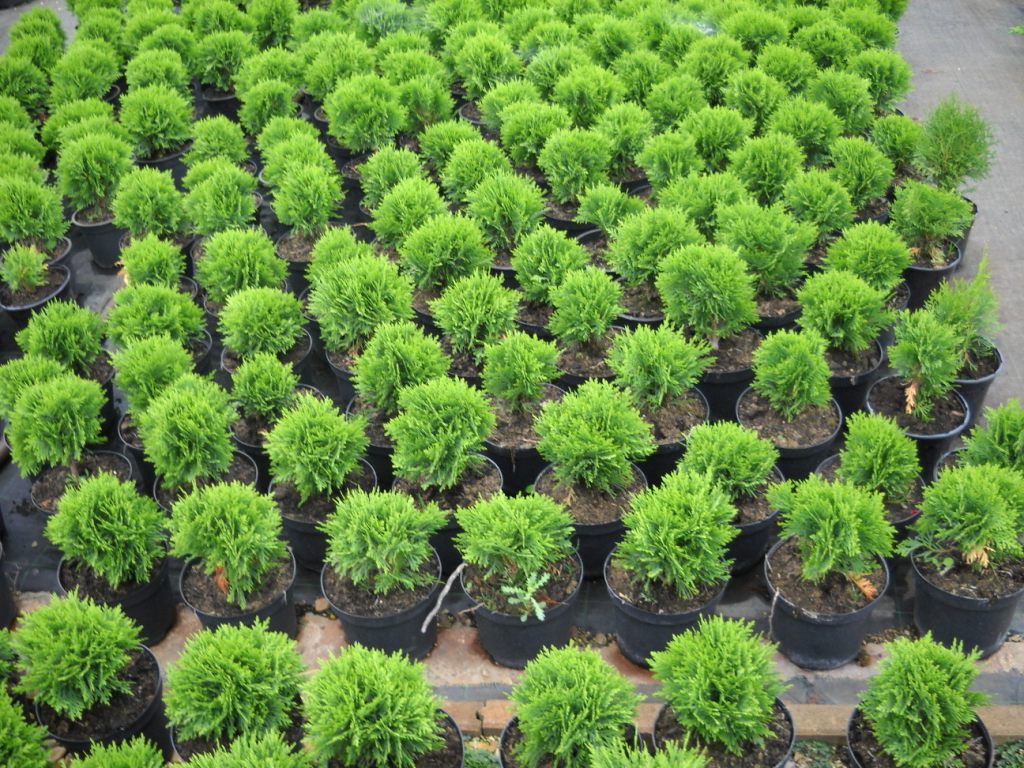
Care for thuja Danica
To begin with, it is worth paying attention to the fact that experts do not at all see the need for regular care for the thuja. And this applies not only to this variety, but to all together. The thing is that even without human help, this vegetation is actively developing. The growth of thuja is especially successful if it is planted in a suitable place. We talked about this earlier.
- In order not to regularly water the thuja, it must be borne in mind that the level ground water should be relatively high for the root system. To determine whether the thuja needs regular watering, its condition should be analyzed for some time. In the event that things are not going well, you should start watering, or apply fertilizer. Perhaps it was just not the best place to land.
- As we have already said, when planting a thuja in a pit, a certain amount of fertilizer is laid. Often it is enough for the active growth of an ornamental plant for two years. After that, you need to fertilize the soil again. Accordingly, something similar should be done approximately every 2 years, while it is necessary to monitor the thuja in general, perhaps feeding may be needed earlier.
- Thuja shoots are sheared with a pruner. You can remove no more than 1/3 of the shoot. After the winter period, dry shoots appear, which must be lost in the spring. It must be remembered that a haircut is necessary to maintain the attractive appearance of the thuja, and it is from this information that one must build on this case.
- Loosening the soil should also be carried out with some regularity - about once a season. The depth of loosening should be limited to 10 cm.
Separately, it must be said about additional activities related to the care of thuja. As we have already said, thuja is quite undemanding to existing conditions, however, it is worth paying attention to some details, which we partially mentioned earlier. For example, if the air temperature is high enough, and there has been no precipitation for a long time, thuja leaves should be sprayed with warm water. Moreover, this can be done quite regularly, without fear that something will happen to the vegetation. It is worth bearing in mind that watering and spraying are two different things, and both of them are of tremendous importance.
Maintaining the optimum temperature for thuja is also an important issue. The thing is that in a too hot time, the vegetation does not feel very comfortable, so the overall growth of the thuja can slow down significantly, although this may not affect its appearance in any way. In that case there is good exit for those who grow thuja not on the plot itself, but in a pot or other container. You just need to move the thuja to another place where the temperature is within 10-15 degrees Celsius. It is at this temperature that the active growth of thuja occurs.
If possible, in the summer for thuja, you can create an "artificial" shadow. The essence of this idea is that too intense sun rays negatively affect the state of vegetation, and a shadow can be created by creating some kind of tree structure, or by planting a tree.
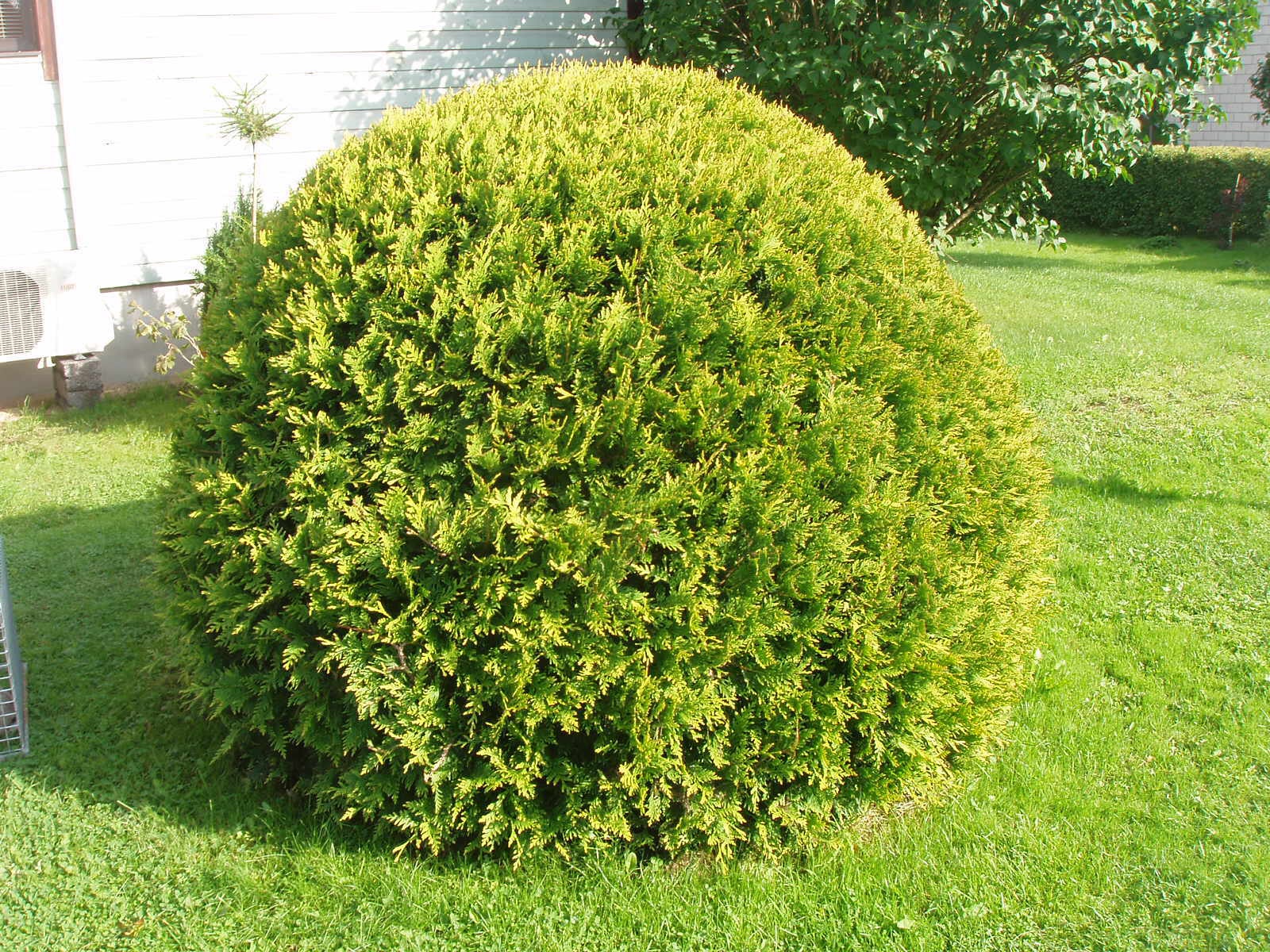
Diseases and pests of thuja Danica
It is known that thujas rarely succumb to some diseases or pests, but such facts definitely exist. Much depends on the existing conditions, including the territory, which may differ in the presence of many pests that are directly dangerous for the arborvitae.
- The most dangerous pests include aphids, spider mites, leafworms, moths, thuja beetles, scale insects and some others. Due to ticks and aphids, the thuja may begin to turn yellow, and later a general deterioration in the condition of the thuja may begin.
- Needle-eating pests are also common. Often, because of them, the leaves acquire a brown color, and directly the tops of the shoots may even begin to die off.
- Root pests are the most dangerous, as the root is the most important part of the vegetation.
As for the prevention of pests, attention should be paid to the fact that today in gardening stores you can find dozens of different means with which you can easily lose even the most tenacious organisms that harm thuja. It is important to pay attention to the fact that it is not easy to identify diseases on a thuja, since the needles are small, you need to look closely. In this regard, care for many other plants is easier to produce. At least a couple of times a year, you need to conduct a thorough inspection of the thuja, while paying attention to even the smallest details.
If we talk about the common diseases of Tui Dannika, then they also have a place to be, however, it must be borne in mind that they are very rare.
- Stem rot. It is almost impossible to trace the very beginning of trunk decay, but when the process has already begun, the needles begin to change their color. If this symptom occurs, you should immediately respond so that it is not too late. The most common cause of root rot is a fungus. Experts recommend simply destroying the thuja if other plant crops are present nearby. The thing is that this disease can also pass to neighboring thujas, if they are present, as well as to many other plants. As for prevention, it is recommended to occasionally water the thuja with a fungicide.
- Root rot. Again, this disease is extremely serious. It can be distinguished from other ailments by the fact that the thuja needles begin to acquire a gray tint. Moreover, the plant may even begin to dry out, and the lower part of the trunk becomes soft enough that it can be pushed through with a finger. Again, the problem lies in the fungus, which is gradually destroyed by the measles system, thereby making the thuja practically inanimate. As in the previous case, it is advisable to destroy the thuja, as well as to replace the soil for planting, as traces of a dangerous disease may remain in it. All measures should be carried out quickly and decisively, since the life of other plants depends on them.
- Brown mold. This disease manifests itself immediately after the snow melts. Surely many have seen a kind of cobweb coating on plants. This is the same disease that affects many cultures. It is known that this disease appears under the snow, when the temperature reaches almost zero degrees. In this case, you should immediately remove the inanimate parts of the thuja, as well as remove all the cobwebs, which may have managed to spread throughout the shrub. Additional processing with special tools available in specialized stores will not hurt either.
If we talk about some general measures necessary for pest control, then you should pay attention to the preparations Aktellik and Fufanon, which are actively used by gardeners. There are many other means that, perhaps, in certain conditions will demonstrate greater effectiveness.
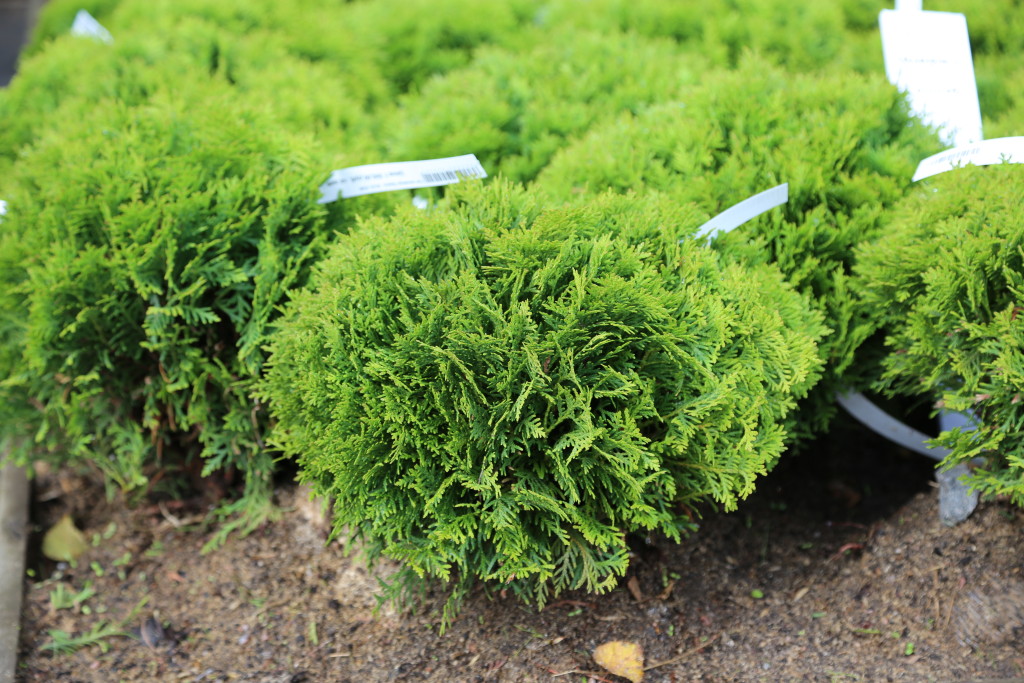
Reproduction of Tui Danica
First of all, it must be borne in mind that thuja is propagated by seeds or vegetatively. It is worth noting that the use of seeds is not a very effective option for obtaining a large full-fledged plant, since in this case only a few among thuja take root (the situation is approximately the same with most other plants).
Thus, it is advisable to make a choice in favor of cuttings. This is the best option, not only because the probability of active growth of thuja will be more than 70%, but also because the owners get exactly the kind of thuja that they need. Accordingly, you can buy several cuttings, while having approximately the same plants, which will be the best solution for the decorative component of the site.
- The cutting process begins with the removal of needles from the bottom of the shoots. The shoots must be transferred to the water, where they should stay for about 2 hours.
- It is advisable to plant the cuttings in a small greenhouse (translucent container) along with the substrate, which consists of turf with peat and sand (1 to 1).
- Immediately before planting in the soil, you need to disinfect the stalk with potassium permanganate. After that, there will be no pests left that can cause serious harm to the plant.
- When germinating cuttings in a small pot, you should also take a glass container and cover the cutting with it. Such a greenhouse must be regularly ventilated, otherwise the plant will stop developing and begin to actively rot.
- Also in the greenhouse you need to carry out a small spraying of the future thuja. To do this, you need to arm yourself with a spray bottle and warm water.
- Despite the fact that already at this stage the thuja can give roots, it should be borne in mind that it is still very early to transplant into full-fledged soil on the site. Everything should be done to ensure that the plant has acquired a sufficient root system necessary for further growth in an open area.
- Gradually, the cuttings need to be left open (without a container on top) for longer and longer so that they gradually adapt to existing conditions.
- Next, there is an active hardening of future thujas. To do this, you need to wait for warm weather and regularly take the cuttings outside. Peculiar "air baths" will positively affect not only the development of the cuttings, but also their endurance to external conditions.
- Now, when the time comes to plant cuttings (approximately after winter, or even in autumn), special attention must be paid to caring for the vegetation. Although the cuttings may be quite resistant to the existing conditions on the site, intensive care should be applied. With its help, the cuttings will take root much faster, and the growth itself will be active.
- Toward the end of autumn, it is necessary to carry out the warming of small thujas, and for this it is necessary to cover them with spruce branches, or with leaves, sawdust, or special materials available in garden stores.
It is necessary to pay attention to the fact that when planting thuja needles should not touch the ground. That is why it is necessary to carry out a fairly large pruning of the lower part of the plant. In the event that the needles still have contact with the ground, gradual decay is unlikely to be avoided. Also, do not forget that on sale you can find a huge number of mixtures and other products that will significantly accelerate the growth of thuja.
Recently, thujas have become more and more popular. The abundance of varieties and the unpretentious nature of these amazing conifers make them indispensable in decorative design city parks and alleys. Thuja spherical gives a special zest to landscape compositions.
In this article, we will consider the variety of thuja western Danica. This is a dwarf variety with a compact spherical crown. largest size in diameter - only 0.5 meters, maximum height - 0.8 cm. It grows very slowly - the increase in growth per year is only 5 centimeters, in width - 4 cm. The bark of the bush is reddish or brownish-gray, flakes off over time . Thuja Danica has thick, soft and shiny scaly needles. The crown is formed by short shoots, densely spaced to each other. The branches are directed straight up. It blooms, which means that thuja rarely bears fruit. The fruits are small brown cones with a diameter of just over 0.5 cm.
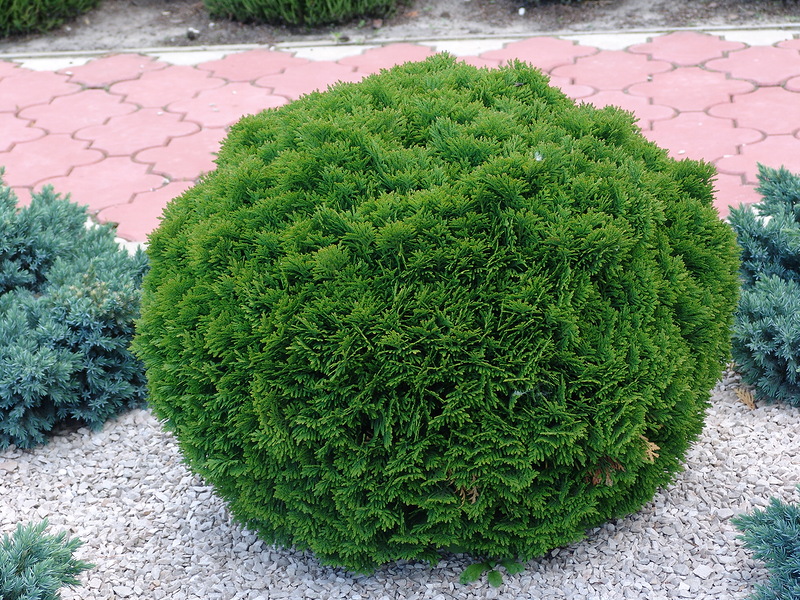
Botanists call this shrub Thuja occidentalis Danica and refer to the thuja species of the western cypress family. This variety was bred in Denmark, which is why it was called thuja western Danica.
Aurea variety is very similar to thuja Danica. This variety of the species in question has a golden hue of the crown and grows even more slowly. But it can grow even higher than the Danica thuja itself - the maximum height of the Danica Aurea thuja can be about a meter, and the width can be up to 1.5 meters.
Features of care
Tuyu Danica, based on the description of the variety, can be safely called the most unpretentious of all representatives of this class of plants. She feels equally great in a sunny area and in partial shade. Undemanding to the soil. Neutral or slightly acidic soils are suitable for her (but still it is worth making sure that the pH of the soil pH does not exceed 5). Like all thuja, it tolerates a certain amount of lime in the soil well (such plants are sometimes even called calcephiles). If the soil where the thuja has to be planted is acidic, the addition of lime to alkalize the soil substrate is required.
Thuja Danica does not impose special requirements for watering, it is quite capable of withstanding a short dry period. A great danger for her is the stagnation of groundwater in the near-stem zone - excessive moisture can cause root rot, disease and death of the plant. Therefore, when planting a seedling, it is necessary to ensure good drainage - for this purpose, pieces of brick, gravel or expanded clay are laid on the bottom of the hole.
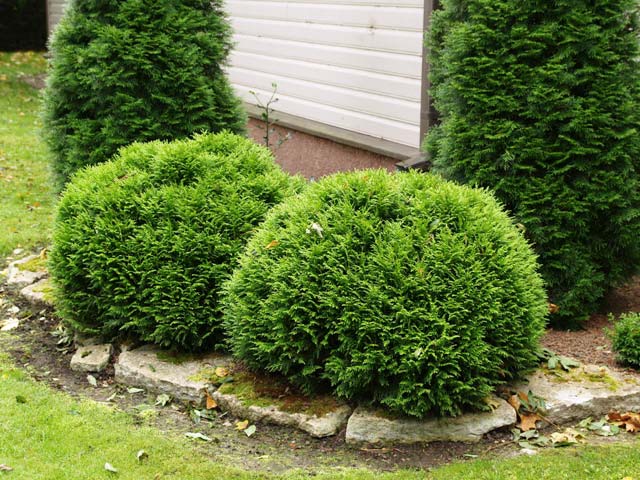
Usually thujas do not need subcortexes. Thuja, grown in a pot, which is offered to us in a garden store, is already supplied with extended-release fertilizers, which, as a rule, are enough for the first years of life. Over the next years, they are rarely fed, while using complex fertilizers for coniferous plants. A balanced application of nitrogen and calcium compounds will make the crown lush and healthy.
When planting a purchased tree, the hole is made larger than the flowerpot itself. The seedling is mixed into the ground along with a clod of soil from the pot, the roots are carefully leveled, trying not to injure them, sprinkled with earth and watered well. From above, the earthen layer is covered with weeds or straw, so that the moisture does not evaporate so quickly.
The first years after planting, the young thuja requires attention and careful care. Before the tree is fully established and adapted, it is regularly watered. Mature shrubs are watered less often. By winter, seedlings of the 1st year of growth are covered with non-woven material or burlap. Such manipulations will save the young from frost and the bright February sun. The winter sun is also dangerous for thuja - due to the temperature difference on the soil (the roots are still cold) and in the air near the crown, needles can burn. If a lot of snow falls in winter, the seedlings can not be covered.
Danica is resistant to diseases, like all members of the genus. Occasionally, the tree is affected by fungal diseases. To prevent them, the bark of the shrub is treated with preparations based on fundozol.
Of the pests, one should be wary of scale insects, false shields, the invasion of cypress and thuja aphids, thuja moths and spider mites. Very often, pest larvae are much more voracious than adults - as is observed in the case of spider mites. Timely and thorough treatment with various pesticides.
Subtleties of multiplication
Propagate thuja Danica cuttings and sowing seeds.
As mentioned in the description of the plant, this bush rarely pleases with flowering and therefore it is rather problematic to obtain seed material. To obtain seeds, thuja cones are selected in November or December. They are dried for some time in a cool place - after such a procedure, it is easier to extract the seeds from them. Before sowing, they are stratified - they are kept for some time under a layer of snow (this greatly increases their germination). With the onset of spring, the seeds are planted in the soil to a depth of 0.5 cm with a distance of more than 10 cm from each other and covered with light soil with the addition of chopped needles. After three years, young seedlings grown from seeds can be transplanted to a permanent place of growth.
When using this method, a fairly good germination of seeds is noted, but the resulting plants almost do not retain external signs desired variety.

Cuttings during propagation of thuja Danica are used more often. Annual shoots are cut as cuttings and blanks are made in cloudy weather. Before planting the cuttings, it is recommended to keep them in a weak solution of potassium permanganate for 24 hours (the potassium permanganate solution in this case disinfects fresh sections). A day later, the cuttings, slightly tilted, are embedded in the ground. It is better to do this in a greenhouse - in such conditions, the formation of roots will occur faster. It is advisable to cut the thuja in the spring - then by the autumn of this year the cuttings will take root and get stronger. In cuttings cut in summer or autumn, the roots will begin to develop only the next year. The place of the branches that were used as cuttings is also important. In order for the bush to have a beautiful and even crown, it is necessary to cut the cuttings from the central shoots.
Both methods of reproduction of thuja are quite complicated, planting and caring for young trees require special care. Garden supermarkets and nurseries offer thuja seedlings in flowerpots that are already prepared for planting in open ground.
The use of thuja
The decorativeness of the thuja Danica is difficult to overestimate. This kind of evergreen tree, as well as thuja Danica Aurea, is just a godsend for landscape designers. These shrubs are planted along the borders, in flower beds and alpine slides. They look very advantageous both as single landings and as a component of landscape compositions. From a small bush of thuja Danica, you can form a green sculpture of any shape - it will last for a long time due to the extremely slow growth of this plant. Small dimensions make it possible to grow this tree at home, and decorate open verandas and balconies with it.
Thuja western spherical is a plant of the cypress family, which belongs to dwarf thujas. This variety of western thuja was bred back in 48 in Denmark. It is for this reason that the plant is called "Danica". Thuja is a spherical shrub. Read on and how to care for her.
The spherical shape of the shrub - thuja western danica
Description of thuja Danica
Thuja is one of those plants that are very popular with landscape designers.
- The height of the thuja of this variety reaches a level of 0.5 m.
- The spherical crown is approximately one meter in diameter.
- Thuja spherical Danica develops incredibly slowly. For a whole year, the plant grows in height by only 4 cm, however, the increase in width is the same.
- The crown of the thuja danica is distinguished by its density and spherical shape.
- The needles have the following properties:
- Green;
- soft;
- scaly.
- As for flowering, it is completely uncharacteristic for this variety.
- Cones on it are formed quite rarely and reach a size of 6 mm.
- The needles of a young plant are vertical thin needles, which are only 0.1 cm long. These needles are called “jewelry needles”.
- With age, these needles replace the scales, which grow in such a way that they overlap each other.
- According to experts, these dwarf plants, with proper care, can delight their owner with a rich green color throughout the whole year.
- She is cold tolerant. It is worth covering only fragile one-year-old plants.
- Thuja of this variety can develop and grow for a hundred years. Read about winged euonymus here:
The features of the plant include twigs that grow in an upright position and thin needles. It is due to this feature that this variety is popular.
Varieties and types of Tui Danica
On the territory of Russia, this variety of dwarf thuja appeared relatively recently. But today it is perceived as one of the best representatives of the decorative type of thuja. This plant is very similar to western thuja"Golden Ball". These varieties differ only in needle color and crown diameter.
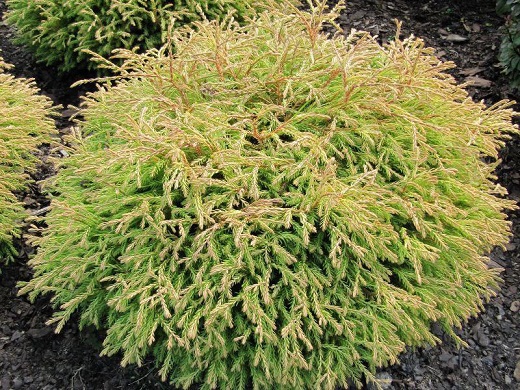
The most popular today is the thuja variety Danica Aurea. This variety has gained its popularity only due to its appearance, but also because this variety is able to withstand temperatures down to -29 ° C. It should be noted that in the first two years of life, the plant requires protection from low temperatures.
Photo of thuja Danica in landscape design
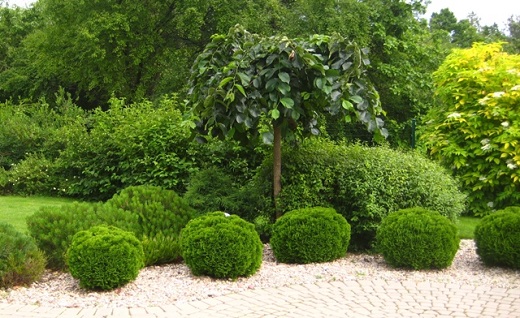
She will feel comfortable on flowerbed ensembles near the administration building, on home gardens. suburban areas or in a modern front garden. Excellent globular thuja suitable for landscaping Japanese style or for small alpine slides. Due to its unpretentiousness, thuja can also be used as a decoration for a terrace or balcony.
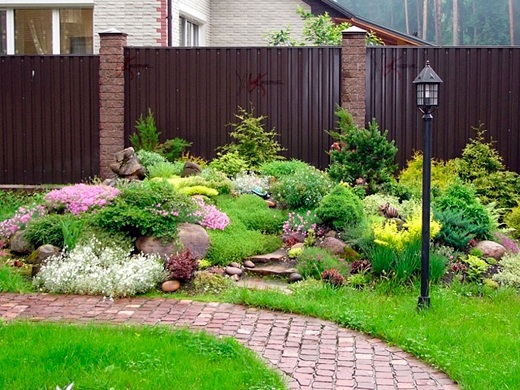
An excellent spherical dwarf thuja is suitable for forming a hedge. Due to its flexibility and adaptability, it can “take” absolutely any form, up to the image of an animal.
An experienced gardener can create even geometric shapes from thuja.
Planting and caring for thuja Danica
The Danica variety is propagated by cuttings. For its cultivation, a woody cutting is taken and germinated in a greenhouse. You can do it easier and buy a grown plant in a nursery.
To plant a plant in the soil, you must:
- prepare drainage from expanded clay or crushed stone,
- check for running water
- plant the plant so that the root collar is at ground level.
- It is worth sprinkling thuja with a mixture of sand, nitroammophoska, sand and soddy land.
For the first few months, the plant should be watered weekly.
Advice! Thuja should be planted in the spring; in the autumn, the gardener subjects the young seedling to serious tests. In addition, in the fall you will need to fertilize the plant more.
Caring for a thuja of this variety requires a lot of time. It is necessary to monitor the soil moisture, feed the thuja and pay attention to the root system, if it starts to rot, then it will not be possible to save the plant.
Price for thuja western Danica
Thuya Danica is a form of western thuja, which belongs to the genus cypress. This species was introduced to the Kingdom of Denmark (from the name of which the name is formed) in 1948. Outwardly, Danica is a shrub that resembles nothing more than a ball. Its average height is about 7 millimeters, and the crown diameter is no more than one mm. Danica is distinguished by long growth: in a year, the plant grows no more than about 4 centimeters both in width and in height.
Danica has a fairly compacted spherical crown. It is worth noting that the needles are green and soft, microscaly. Characteristic of the tree is the presence of graceful needles and vertically raised branches. Their similar position on a pair with a fortress of a regular crown determine the prevalence of the species.
Flowering is not characteristic of Danica. Small cones (no more than 6 mm, brown, rounded) are quite rare. Along with other plants of its kind (cypress), thuja has the following distinguishing feature: the needles of early seedlings are needles up to 10 mm long. Then, as the plant grows, they are replaced by flat cups, overlapping each other.
Thuja in landscape design
To create various flower beds (for example, rock gardens), it is recommended to use the Danica variety. The spherical shape of the plant is maintained even without pruning. Also, this species is suitable for use in container gardening or patios.
Landscape designers really rightly consider Danica to be a universal plant. Thuja looks extremely impressive in completely different landing sites: these are small or large gardens, and landing alone, and rock gardens. Danica fits perfectly into both the free style of the landscape and the strict one. Also thuja can improve appearance and coniferous-shrub decorative flower beds, a plot in the country or in the village.
The plant will be comfortable in urban conditions (garden, lawn). Due to the type of crown (in the form of a ball), the plant is great, for example, under, or a heather garden. The unpretentiousness of the tree allows it to be grown as ornamental plant for a balcony, loggia or terrace.
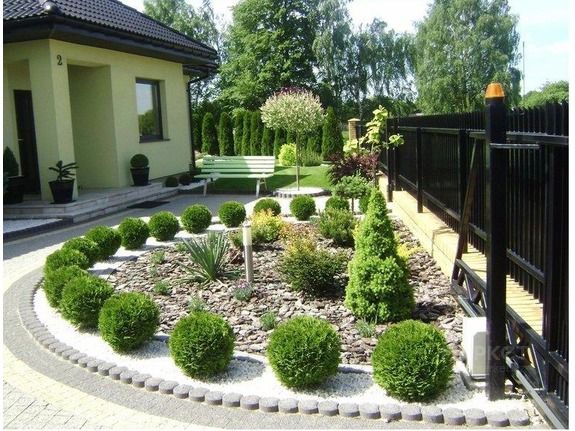
Danica is highly valued by connoisseurs of hedges. Small trees densely spaced relative to each other form medium-sized decorative borders. Given the fact that Danica calmly tolerates a change in the shape and length of branches, gardeners with taste can make a kind of work of art from an ordinary hedge in the form of animal figures, for example.
Danica is an unpretentious plant that will become a favorite plant in the garden. It will delight with its unique spherical crown of greenish color without interruption. Under proper conditions and appropriate care from gardeners, this evergreen plant can please the eye with its existence for up to two hundred years.
Also, in addition to the greenery of the thuja, as advantages due to which the thuja plays an important role in the garden, one can note its magnificent aroma, as well as high resistance to frost and high humidity, a stable state of comfort even with a long stay in the shade. Thanks to this, thuja won the hearts of gardeners all over the world, participating in landscape design.
Tui look good even without participating in various plant compositions, by themselves. But this does not mean that they should not be used next to other plants. Any plants can be called excellent neighbors. The thuja will also look next to either swordtail elecampane, or purple echinacea.
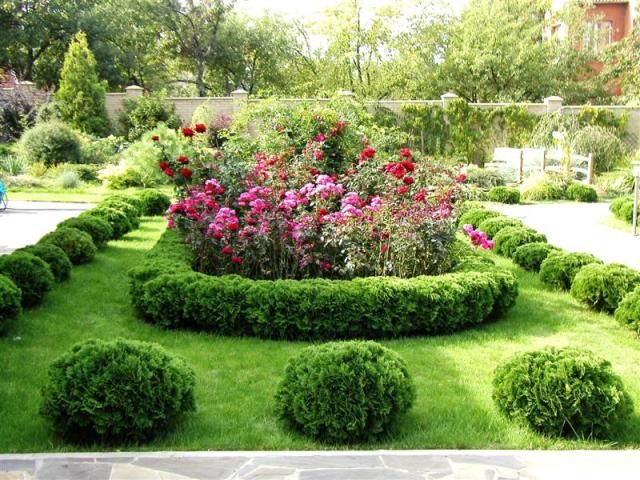
It is almost impossible to remain indifferent to thuja. Just one plant planted on your site will stun you next year with its appearance and motivate you to plant another thuja, and, possibly, of a completely different variety. This shrub allows you to experiment in various ways without spoiling the look of the site. Tui in absolutely any period of time will be in place, and in general they look truly unimaginable.
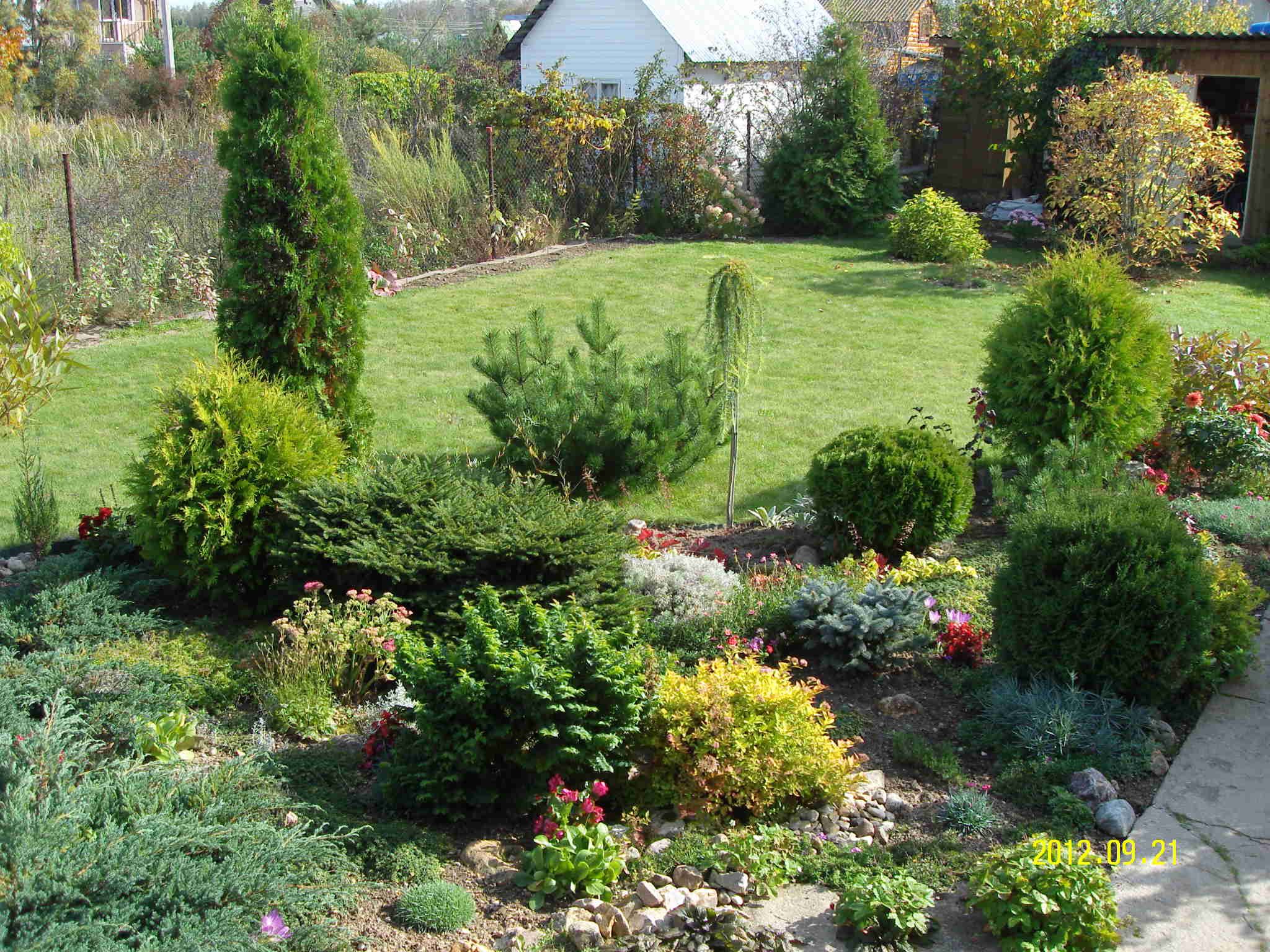
Species and varieties
Of the varieties of western thuja Danica, there is only one variety, this Danica Aurea.
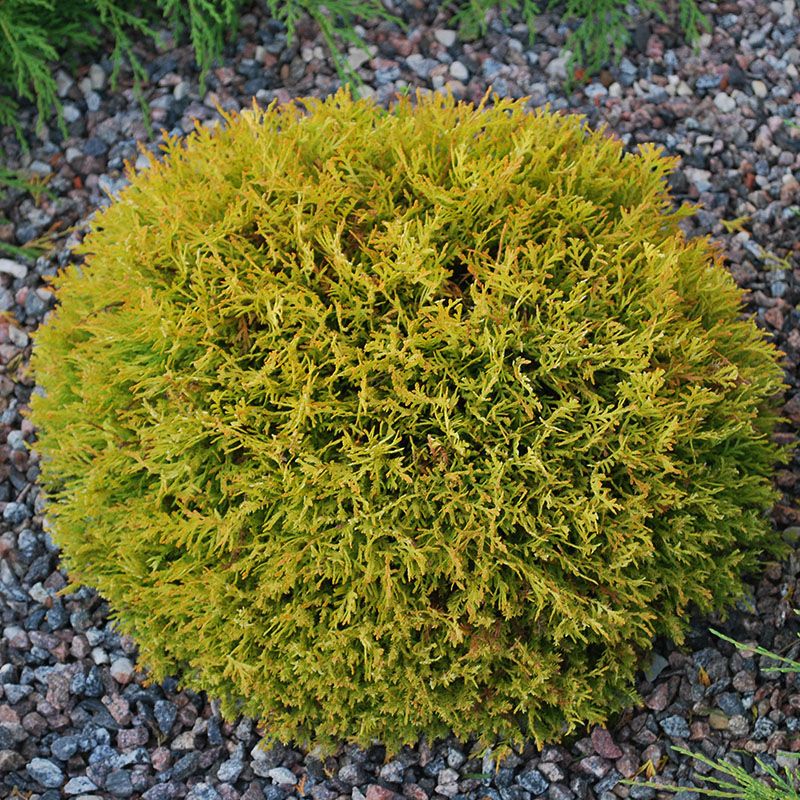
Just like the more popular variety, it is very much appreciated for its small size. It has a gilded color, and in itself looks concise. It is often used in rock gardens, also in group plantings with completely different ones. Various designers also advise using Aureu if you plan to design your own garden in.
And, of course, like Danica, plants are used to plant rockeries.
The growth rate is actually the same, perhaps quite a bit less - 2-4 centimeters per year, and the maximum height reaches about 0.8 meters. Experts also recommend protecting the flowering ball from winter and spring burns for the first couple of years.
- It has scaly needles, as soft, as thick as Danica's thuja.
- Growth conditions must be met. The variety is photophilous, grows, as a rule, on fertile soils.
- A feature is that in winter it acquires a pronounced shade of bronze.
It has an extremely high winter hardiness, but certain conditions are required, namely, Danica Aurea needs shelter from the early sun in the spring, which is very important. Regarding spring, it is recommended to carry out preventive treatment from any pests during this season, even though Aurea is unusually high in disease resistance.
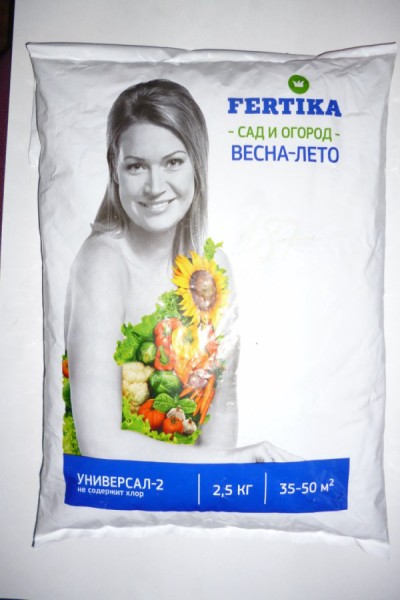
especially in spring, but only a few years after planting, unless of course there was a fertilizer consisting of minerals. In the very first month, it is worth spending ten liters per week on watering and sprinkling. In dry conditions, to which the plant is rather poorly tolerated, about twenty liters should be spent, twice a week, otherwise the crowns of the plant will begin to thin out, which few people will like.
Planting, care and reproduction
Lignified cuttings are most often used by Danica for propagation. They are subjected to a heteroauxin treatment and then germinated under proper greenhouse conditions.
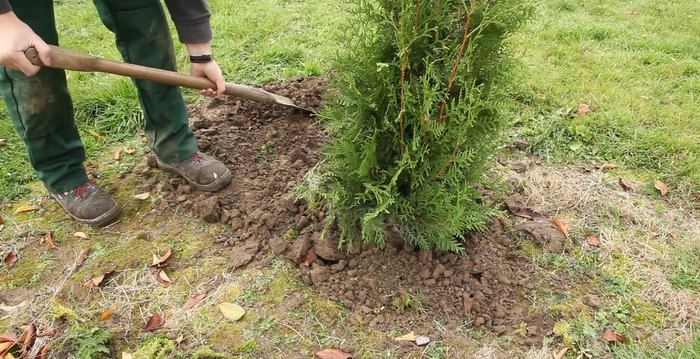
In the event that it was not possible to obtain cuttings of the required strength, buying ready-made seedlings would be the best option. It is best to plant Danica in the spring, because in the summer it is resistant root system has time to form, it turns out that by the cold winter period the plant will already be rooted. In the case, gardening of the site is planned at another time, planting at any other time of the year, except for winter. A loamy place with high fertility is required. It will be good if there are no dirt oxen nearby. In case this is not possible, a 20 cm crushed stone drainage system must be taken care of.
Sand, peat and earth with nitroammophos make up the mixture that is used for the planting hole. After mixing, pour it into the pit in the form of a slide. This allows the root neck to be not below ground level, but approximately on a par with it. After all this, the plants are watered. The first month it is carried out once a week. Planting Danica implies that the distance between the trees during planting will be from 30 cm to 3 meters. For a hedge, the distance is about half a meter wide, and a little less in a row, about 40 cm.
In the case of a dry summer, it is necessary to water each seedling in volumes of 15-20 liters. After watering, shallow loosening is recommended. Mulching is also welcome, for example, with humus.
Despite the high resistance to an overabundance or lack of anything Danica, for everything you need to know the measure. The plant will grow well in a small shade with the required amount and amount of watering and top dressing, respectively. This will significantly increase the density of the crown, the needles will look more saturated. It also improves its decorative properties in thuja. In late spring or early summer, it is strongly recommended to apply organic and mineral fertilizers to the root zone.
Plant care is carried out by cleaning dry and damaged branches in the spring. You can also modify the crown, cut the plant, transplant it. In winter, burlap will serve as a salvation from the cold and winds, with which you can cover the plant. Fortified shrubs, such protection is no longer needed.
Video - review of Tui Danica


